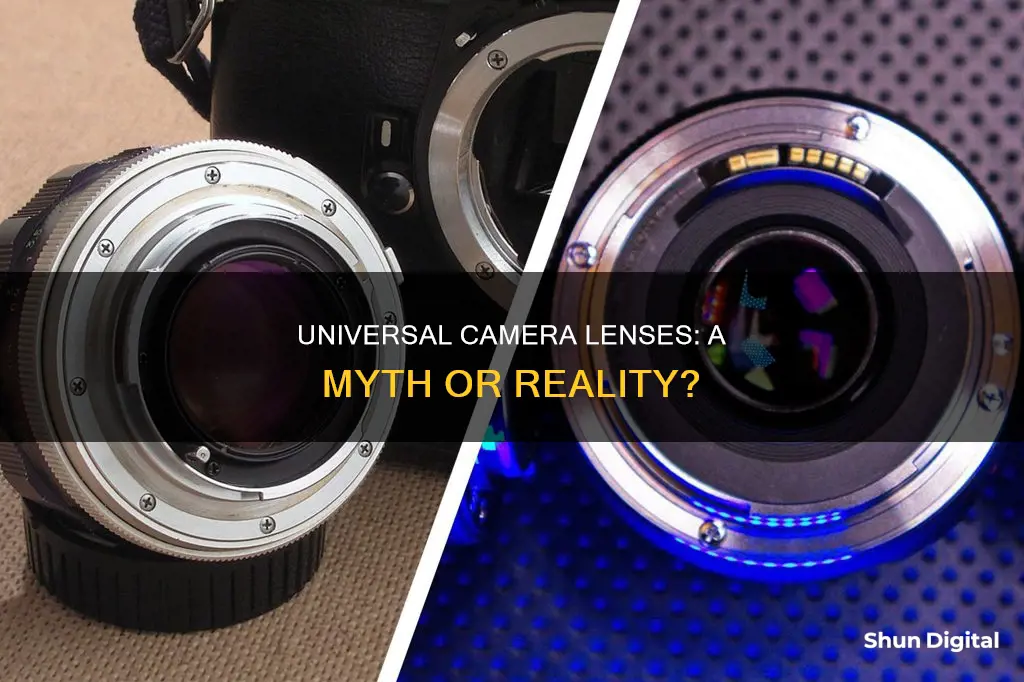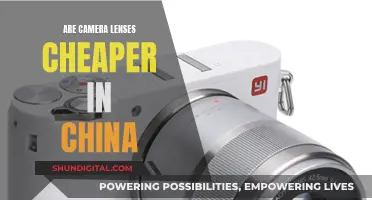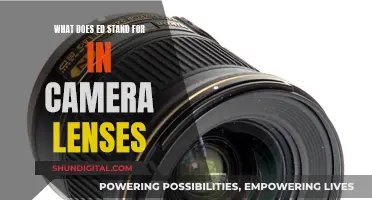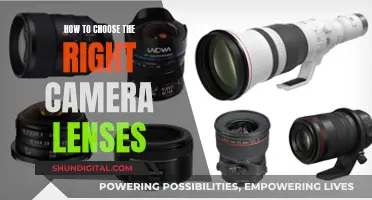
Camera lenses are not universal, and their compatibility depends on the brand and type of camera you are using. While many lenses are interchangeable, allowing photographers to adapt to specific shooting situations or genres of photography, they are not always compatible with all camera bodies. Different camera brands typically use their own unique lens mount designs, which means that lenses from one brand may not fit the camera of another brand. For example, a Canon lens won't fit a Nikon camera. However, within a specific brand's lens ecosystem, there may be a wide range of interchangeable lenses that are compatible with certain camera bodies. Additionally, lens adapters can sometimes be used to make lenses compatible with different camera mounts, but this may come with certain drawbacks and limitations.
| Characteristics | Values |
|---|---|
| Interchangeability | Depends on the brand and type of camera |
| Universal Compatibility | Not universal |
| Lens Mounts | Vary between brands and even within brands |
| Lens Mount Direction | Clockwise or counter-clockwise |
| Throat Size | Varies based on the diameter of the circular hole in the camera |
| Inner and Outer Diameter | Inner: length of the throat; Outer: length of the mount, including tabs |
| Flange Distance | Distance from the outer lens mount to the camera sensor |
| Angle of Incidence | Affected by camera and lens measurements |
| Lens Options | Standard, wide-angle, macro, telephoto zoom, prime, specialty |
| Lens Performance | Aperture, autofocus, image stabilization, build quality |
| Third-Party Lenses | Available from Sigma, Tamron, Tokina, and other manufacturers |
| Lens Adapters | Available but may limit camera functionality |
What You'll Learn
- Camera lenses are not universal, but many are interchangeable
- Lenses are not universal because of their unique purposes
- Different camera brands use different lens mounts
- Lens mounts vary in throat size, inner and outer diameter, and flange distance
- Smaller camera companies often use the lens mounts of larger companies

Camera lenses are not universal, but many are interchangeable
The compatibility of a lens with a camera depends on the camera brand and type. For example, a Canon lens won't fit a Nikon camera. Even within the same brand, different camera models may have different lens mounts, so a lens meant for one camera model might not fit another.
Lens mounts refer to the junction where the camera and lens meet. Each camera brand uses a specific lens mount, and sometimes, different mounts for different camera models. For instance, Canon has four common lens types with different mounts: EF, EF-S, RF, and EF-M. Nikon uses the F-Mount for most DSLRs and the Z-Mount for its full-frame mirrorless cameras.
Lens mounts can differ in several ways, including the mounting direction (clockwise or counterclockwise), throat size (diameter of the circular hole in the center of the camera), inner and outer diameter, and flange distance (distance from the outer part of the lens mount to the sensor of the camera). These differences can impact the functionality of your camera and lens, such as the amount of light that reaches the camera sensor and the size of the camera body.
While it is possible to use a lens adapter to attach a lens from one brand to a camera body of another brand, this may come with drawbacks. For example, the adapter may affect the autofocus, manual focus, aperture control, vibration reduction, and metering of the camera and lens system.
When choosing a new lens for your camera, it is essential to ensure compatibility by checking the specific lens mount used by your camera. You can usually find this information in the camera's manual or on the manufacturer's website.
Protect Your Camera Lens: Storage Tips for Photographers
You may want to see also

Lenses are not universal because of their unique purposes
Camera lenses are not universal because they serve unique purposes. Different lenses are designed for different types of photography and have distinct characteristics, such as focal length, aperture, and zoom capabilities. For example, a wide-angle lens is perfect for landscape photography, while a macro lens is ideal for capturing intricate details of small objects like flowers or insects.
The unique design of each lens influences the look and feel of the final image, allowing photographers to achieve their desired artistic vision. Interchangeable lenses empower photographers to adapt to specific shooting situations and genres of photography, giving them greater creative control over their images. For instance, a shallow depth of field may be preferred for portraits, while a wide-angle perspective is often chosen for landscapes.
Additionally, camera lenses are not universal across brands and types of cameras due to differences in lens mounts. Each camera brand typically employs its own proprietary lens mount, which may vary even within the same brand, depending on factors such as camera size and specificity. For example, Canon EF lenses are compatible with any Canon EF mount camera but will not fit a Sony E mount camera.
While some lenses can be adapted to work with different camera brands using lens adapters, this may come with drawbacks, such as the loss of certain features and functions. Therefore, it is essential for photographers to carefully consider their specific needs and choose lenses that align with their photography goals and camera specifications.
Cleaning Camera Lenses: A Step-by-Step Guide
You may want to see also

Different camera brands use different lens mounts
Each camera brand has its own proprietary mount, and even within a brand, different camera models can have different mounts. This means that a lens may not be compatible with all camera bodies from the same brand. For instance, Canon's EF-lens mount, introduced in 1987, is different from its newer EF-S-mount, used for cameras with APS-C sensors.
Lens mounts can differ in several ways, including the mounting direction (clockwise or counterclockwise), throat size (the diameter of the circular hole where the lens is attached), inner and outer diameter, and flange distance (the distance from the outer part of the lens mount to the camera sensor). These differences can impact the functionality of the camera and lens, such as the amount of light that can enter the camera and the camera's size and autofocus capabilities.
While some third-party lens manufacturers produce lenses that fit multiple brands, such as Sigma, Tamron, and Tokina, it's important to ensure compatibility by checking the lens mount and sensor size before purchasing.
Additionally, while DSLR and mirrorless cameras are designed to use interchangeable lenses, lenses from a DSLR may not be compatible with a mirrorless camera, even of the same brand, without an adapter. This is because the lens mount on a mirrorless camera is typically closer to the sensor, and vice versa.
In summary, when choosing a lens, it's crucial to consider the specific lens mount and sensor size of your camera to ensure compatibility and avoid limitations on your camera's functions.
The High Cost of Camera Lenses: Why So Expensive?
You may want to see also

Lens mounts vary in throat size, inner and outer diameter, and flange distance
The compatibility of a lens with a camera depends on the lens mount, which is the opening that allows the lens to be attached to the camera body. The lens mount is more than just a physical hole, it is an interface that enables the lens and camera to communicate with each other. Lens mounts vary in several ways, including throat size, inner and outer diameter, and flange distance.
The throat size of a lens mount is the inner diameter of the mount, excluding the tabs used for mounting the lens. It is an important measurement as it provides a more accurate representation of the mount's potential. The inner diameter of a lens mount, on the other hand, includes the tabs on the mount and is often provided by manufacturers to give an idea of the overall size of the mount. The outer diameter of the lens mount refers to the full diameter of the bayonet mount, which is usually the end of the metal mount.
Flange distance, also known as "flange focal distance" or "register", is the distance from the outer part of the lens mount to the film or sensor plane. This distance can vary significantly between different camera systems. A shorter flange distance allows for the design of thinner, more compact cameras and enables faster autofocusing.
The size of the lens mount and the flange distance play a crucial role in the performance of a camera system. A larger lens mount allows for larger lenses that can provide more light to the sensor, resulting in faster lenses. However, a larger throat diameter can also lead to larger and heavier lenses. A shorter flange distance enables the placement of lenses closer to the sensor, facilitating the design of simpler, smaller, and less expensive lenses.
In summary, variations in throat size, inner and outer diameter, and flange distance among different lens mounts impact the compatibility and performance of camera systems. These factors influence the amount of light reaching the sensor, the size and weight of the camera and lenses, and the autofocusing capabilities.

Smaller camera companies often use the lens mounts of larger companies
For example, Sigma, Tamron, and Tokina manufacture lenses that are compatible with Canon's EF and EF-S mounts. Similarly, Kodak, Panasonic, and Olympus use a Micro Four Thirds mount. This allows smaller companies to capitalise on the popularity of major camera brands like Canon and Nikon, by providing cheaper lenses that are compatible with their systems.
While some smaller brands do have their own unique lens mounts, it is more common for them to adopt the lens mounts of larger companies. This is likely due to the high cost of designing and manufacturing a completely new lens mount system, as well as the convenience and versatility it offers consumers.
It is important to note that even within a single brand, different cameras can have different lens mounts. For example, Canon introduced the EF-S-mount in 2003, which is used for cameras with an APS-C sensor, whereas their previous EF-mount lenses are not compatible with this new mount. Therefore, it is crucial to check the specific lens mount of your camera before purchasing new lenses, even if they are from the same brand.
In summary, smaller camera companies often use the lens mounts of larger companies to ensure compatibility with popular camera systems and offer more affordable options to consumers. This practice can provide convenience and flexibility to photographers, but it also highlights the lack of standardisation in the industry, which can sometimes be frustrating and limiting.
Frequently asked questions
No, not all camera lenses are universal. While many lenses are interchangeable, allowing photographers to adapt to specific shooting situations or genres of photography, they are not necessarily universal across brands and types of cameras. For example, a Canon lens won't fit a Nikon camera.
Camera lenses are not universal due to the unique purposes of different lenses and cameras. Each lens has its own characteristics, such as focal length, aperture, and zoom capabilities, which make them suitable for specific types of photography. Additionally, camera brands often have their own specific lens mounts, which means that lenses from one brand may not fit cameras from another brand.
To determine if a lens will fit your camera, you need to identify the lens mount that your camera uses. Different camera brands use different lens mounts, and even within the same brand, different camera models may have different lens mounts. Once you know the specific lens mount of your camera, you can research the compatible lenses available.







